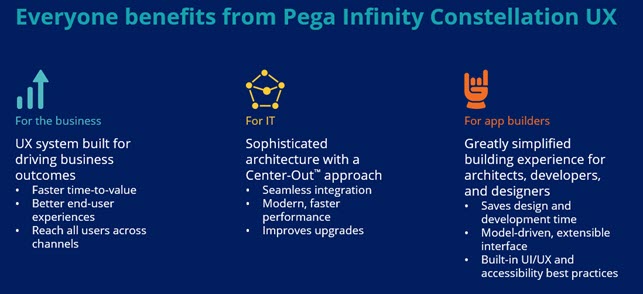Introduction to Constellation architecture
A constellation is a group of stars that form a distinct configuration representing an image of an object or a creature. Although constellations are composed of massive gas spheres hurtling through the infinite void of space, the human eye gives them shape, meaning, and structure. Pega Constellation is exactly the same...
Well, not exactly the same. Pega Constellation is a new architecture for Pega’s low-code app-building environment, Pega Platform™. Similarly to its astronomical counterpart, Constellation has multiple inter-dependent parts, imposes order on unordered reality, and can be viewed from different perspectives:
Pega Constellation follows the model-view-controller (MVC) design pattern, and incorporates microservices and stateless architecture to create modular, independent parts that build up to a larger whole, while also handling client orchestration and supporting extensibility.
Pega Constellation is a UI Design System with which you can design a consistent experience for your users. At the same time, it enables front-end developers to extend the default components and make use of their own design systems and the latest technologies.
Pega Constellation is a true center-out way of creating software. The pattern-based, model-driven approach enables app builders to create applications that are both business oriented and low maintenance. This new development paradigm, which goes hand-in-hand with the Pega Constellation architecture, shifts the focus from customization to configuration, and provides a prescriptive way of designing applications.
While we will delve deeper into every aspect of Constellation in future posts, let's take a quick look around right now!
Similarly to its astronomical counterpart, Pega Constellation has multiple inter-dependent parts, imposes order on unordered reality, and can be viewed from different perspectives.
UI architecture
Constellation UI architecture shifts the paradigm of how you deliver an experience to your users. With the new client-side engine, orchestration of views is done in the browser itself. In this way, the Infinity server no longer has to prepare the view and send big sets of data to the user's device – instead, it can limit the payload to small, data-driven packets.
This major shift away from our traditional architecture brings multiple benefits and flexibility to your solutions. The smaller payload means that users get a more fluent, performative experience, and the system as a whole better utilizes the network - metrics show as much as a 7x smaller network payload and 3x faster interactions!
At the same time, this new orchestration paradigm required a well-defined, granular API. This was necessary to enable the frontend engine to communicate flawlessly with backend services. This has opened the way for frontend developers to extend Constellation’s features by introducing custom components, or to incorporate Pega software into their own corporate design systems. Taken to the extreme, the Pega API even enables web developers to just use the Pega API alone, and add any web-standard frontend (React, Angular, etc.) as they see fit.
New UX and low-code authoring experience
The new architecture comes together with a new authoring experience, a data-driven and API-driven approach, and with client-side orchestration, all of which encourages a more prescriptive approach to application authoring. Additionally, the prescriptive authoring approach allows for decoupling of the presentation layer and the business logic.
By using App Studio, Constellation delivers functionality that enables experienced System Architects to work hand-in-hand with Citizen Developers and Business Stakeholders to create tailored business processes, without the need to customize the presentation layer. The benefits of this approach are that:
- End-users receive consistent experience across different processes and applications.
- Case Type design is focused on business logic and is kept within best-practice guidelines.
- The underlying building blocks of your application are configured (not customized), allowing for seamless upgrades, easier adoption of new features, and an as-a-service approach.
At the same time, whenever needed, the web developers and System Architects can create custom components that deliver project-specific requirements that are easily made available for reuse by other App Studio users.
Constellation design system
As you can see, the Constellation design system can be understood in various ways, depending on the perspective that you take. Furthermore, the interconnected elements of Pega Constellation reveal added value in the structure itself. Taking the new UI architecture and pairing it up with Pega’s low-code authoring experience helps you to organize the entire end-to-end UI/UX experience for your Pega applications. The themes, patterns, and design tokens all add up to creating a coherent and unified design system.
The Constellation design system delivers a prescribed and configurable experience that empowers developers and stakeholders to focus on delivering business value to end users. At the same time, it ensures that the experience is consistent across different channels and business areas, and that the delivery process is efficient and not bogged down or derailed by discussion around the presentation layer. By default, Constellation offers a set of business-focused widgets and components, implementation best practices, and full support for accessibility requirements.
True Center-out architecture
Let's zoom out from the different aspects of UI architecture, prescriptive low-code authoring, underlying API-based and model-driven work-automation platforms, and how they impact the end-user experience, and take a look at Pega Constellation as a whole. When we do that, we can see one more pattern emerging: that Constellation uses true Center-Out architecture.
This concept is brilliantly explained in the Center-out Explained video series, and we’ll dig into the topic in the following posts in the series, so for now let’s just have a quick sneak-peek at what Center-out is all about.
The Center-out concept puts the business value and customer journeys forward, as the principal factors in designing an application. Instead of focusing on the landscape of an app’s underlying systems (the bottom-up approach), or the interaction channels and portals (the top-down approach), Pega Platform enables clients to start with business needs and processes from the very beginning. This not only helps to bring value faster to your end users and stakeholders, but also enables quicker and more consistent expansion and updates. For example, when you want to add a mobile app as an alternative to a web portal, or when you need to expand to a new country, add country-specific requirements to Cases, and create localized language versions.
With Pega Constellation, a true Center-out approach is made possible – its prescribed approach to UI/UX architecture and authoring gives you the tools to start right away with the business journey. The underlying SDK, API, and enterprise architecture enable quick initial setup and future scalability, and the low-code authoring approach in the business layer gives you the flexibility to create business-specific user journeys that can be expanded more quickly in the future. Altogether, Constellation provides a true Center-out experience.
Constellation UX – benefits

It is important to note that all three key audiences – which are part of any Pega implementation project (or even any IT project in general) – can benefit from the powerful combination of Constellation in different ways: businesses will derive more value from their investment in UX, resulting in enhanced end user experiences; app builders and citizen developers will avoid the need to repeatedly reinvent the wheel when designing and developing elements such as button colors, section rules, and screen layouts, and IT departments will experience significantly improved performance and easier upgrades.
To summarize, the benefits across all audiences are:
- Speed: Faster implementation, design, and performance.
- Power: The underlying technology is flexible, but still includes built-in guardrails that adhere to a proper Center-out approach.
- Value: Users can achieve a quicker time to value for UX, and lower costs associated with maintaining and upgrading their systems.
Related Resources
- Constellation on Support Center
- Pega Community Constellation Page
- Constellation Adoption on Pega Academy
- Constellation Documentation
Don't Forget
- JOIN THE CONVERSATION on Support Center
- FOLLOW @PegaDeveloper on Twitter


